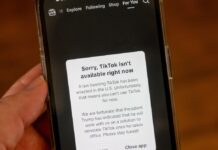“Even VPNs do not lead to circumvention” in India, Gosain told WIRED.
In the early hours of the US ban, it was unclear exactly how feasible it would be to get around the restrictions for US accounts. It seemed that TikTok had taken a more extreme approach, turning any US builds of the app dark—blacking out versions of the TikTok app software that had been made to be downloaded and used by US users. It also seemed that US-linked accounts were being blocked regardless of IP address or SIM country information.
Running a VPN alone was certainly not enough to circumvent the ban and get back on TikTok. But seemingly using a non-US TikTok account after removing a SIM (or on a device without a US SIM card/US phone number) worked when combined with a VPN. Similarly, using a VPN with a desktop browser or the Tor Browser was enough to get a non-US TikTok account to load in the US early on Sunday morning, though TikTok’s desktop version has always been much more limited than its mobile app.
The impact of the ban has been immediate, with internet traffic data from monitoring firm Kentik showing an instant and dramatic drop off in connections to TikTok. On other social media platforms, people are complaining that TikTok is not working on their US-linked devices or accounts even though they are abroad.
TikTok’s privacy policies, which are not unlike those of other social media apps, describe a range of information it collects, which could be used to identify people’s home locations. This includes everything from address information users provide to device system settings, SIM card regions, and other network information. (TikTok’s privacy policy now includes a note saying service to US users may not be available due to the law, calling it an “interruption.”)
In a statement posted online, Apple says if US users delete TikTok or move to a new phone, TikTok and other ByteDance apps can’t be reinstalled. It also stated that the software distribution ban will impact people visiting the US. “Users visiting from outside the United States with their Apple Account set to a country or region that is not the United States are unable to download, update, or make in-app purchases and new subscriptions,” Apple says.
“TikTok inspects the source IP of the network packets—if the source IP belongs to India, it drops the packets,” Gosain explains, of the restrictions in India. “Also, the TikTok app fetches the country information embedded in the SIM card, and if the country code is ‘IN,’ it filters the network connection. When we remove the SIM card, the TikTok app fails to identify Indian users from the SIM card, and when we use VPNs, the IP address changes, and it no longer belongs to the Indian IP range. Thus, TikTok again fails to identify that the user is accessing from India. This is how we bypass the filtering.”
Virtual private networks, or VPNs, work by passing your internet traffic through servers that are physically maintained in locations around the world, so you can select an IP address that is tied to a different location than where you physically are. For example, American TikTok users can use VPNs to make it look like they are accessing the internet from outside the US. VPNs also stop your internet service provider (ISPs) from seeing your browsing data, adding an extra potential layer of privacy. When you’re using a VPN, your ISP will simply see connections to the VPN instead of having access to the detailed list of all the websites you’re visiting.








